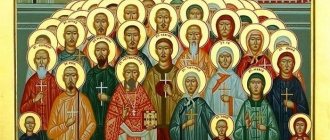Nowadays girls are not called by the name Alla so often. Today you rarely see a little girl named Alla. However, some parents prefer it and call their daughters that. But this is a very beautiful name with an unusual history. It became especially widespread in the mid-twentieth century.
Alla is a name that is reflected in Orthodox Christmastide, but has a deep history dating back to pre-Slavic times. This is a common Christian name (this is what Catholics call children too). The name does not have an official short form, but there are colloquial diminutive variations:
- Allochka;
- Allusya;
- Alya.
When is Alla's name day?
Although this name has an ancient history, in the Orthodox calendar there is only one day a year when the day of the angel Alla is officially celebrated (April 8). On this day, the Orthodox Church honors the memory of the martyr who suffered for her faith back in the fourth century AD, that is, during the persecution of Christians. Saint Alla of Goth was a laywoman.
Little information has been preserved about her life, but there is reason to believe that her tribe lived in the Danube territories or in the Crimea. When King Athanaric came to power, he was furious at how actively his subjects were turning from paganism to Christianity. Athanaric pursued a policy of persecution, persecuting all Christians.
According to legend, the king's protege Vingurik drove a cart with a pagan idol through the streets of the city, calling on everyone to worship the false god and sacrifice him. Those who refused were taken into the building that served as their temple. Among these people was Saint Alla. She, along with three hundred other Christians, was burned alive, but history has recorded the names of only 26 martyrs.
According to another theory, Alla is identified in historical consciousness with Gaafa, the widow of one of the Gothic kings. Here she did not die in the fire, but was stoned to death several years later when she tried to collect the remains of the martyrs to transfer them to Syria. It is not known for certain which theory is correct, since there is generally little information about the history of the Goths.
Martyr Alla Gotfskaya
Alla Gotfskaya[1] is revered by the Orthodox Church as a martyr who suffered for the faith, for Christ. With particular solemnity, believers honor her memory on March 26 (April 8).
Not much evidence has been preserved about the life of Saint Alla. In addition, not all historical information about this martyr that has survived to this day is consistent with each other.
It is reliably known that Saint Alla lived in the 4th century. It is also known that her martyrdom was associated with the death of Christians who were burned alive in the temple during worship. It is difficult to say where exactly, geographically, this temple was located. According to a very general assessment, it was located on the territory of the Danube Gothia.
According to legend, the temple was set on fire by Gothic executioners on the orders of the Gothic ruler Ungerich (Ungerik). Identifying the identity of this ruler also encountered difficulties among researchers. Sometimes he is mistaken for the same person as Athanaric, a hater and fierce persecutor of Christians.
It is alleged that the mass conversion of his subjects to Christ aroused inhuman anger and bestial rage in Ungerich. During his reign, many Christians were brutally tortured and executed, and quite often the executions were carried out without due process.
According to ancient legend, as a result of the arson of a Christian temple at Ungerich, 308 Christians burned. The historical chronicle has brought to us the names of 26 of them; the names of the remaining martyrs are known only to God.
There is evidence that Ungeric ruled during the reigns of the emperors Valentinian, Valens and Gratian. If we accept them as authentic, we must assume that the period of Ungerich’s rule was long. The date of the burning of 308 pilgrims is presumably determined to be the year 375.
According to the famous Life, Saint Alla died in the flames of that same fire, along with other brothers and sisters in Christ. It was then that she was awarded the crown of martyrdom.
Meanwhile, other sources that identify Alla with the wife of another Gothic ruler, Gaatha, have a different opinion. According to these sources, Alla or Gaafa was not among the Christians who died in the fire, but suffered martyrdom several years after the incident.
If you follow this data, after the fire she, together with her daughter Duklida, appeared at the ashes and reverently collected the remains of the burnt saints. Having thus honored the memory of the martyrs, she entrusted the reign to her son and set off to wander.
During her travels, her daughter, Duclida, and several elders were with her. Gaafa moved from place to place until she finally settled in the Syrian country (that is, in Syria). However, there is reason to believe that Gaafa settled not in Syria, but in another country - Rome, on the territory of modern Romania.
Some time later, Gaafa called her son, after which, together with him, she returned to her homeland, to Gothia.
Soon after arriving in the Fatherland, she shed her blood for Christ: she was stoned along with Agathon.
She previously transferred the relics of the burnt martyrs to Duclida for safekeeping. Duklida gave some of them to the Christians of the city of Cyzicus. She rested peacefully in the Lord several years after her mother's death.
The opinion that Saint Alla and Saint Gaafa are one historical person does not have reliable confirmation.
See also: “ Memory of the 26 Gothic Martyrs” as presented by St. Demetrius of Rostov.
Note
[1] Goths (archaized form - "Goths") - a group of Germanic tribes. The Gothic country extended from the lower Vistula to the Black Sea. The Goths lived mainly along the Danube River in what is now Romania. Subsequently they settled almost throughout Europe.
azbyka.ru
Origin of the name
It’s not easy with theories about the genesis of this name, since it is found not only among Christians, but also among Muslims. True, the Arabic name Alla is a masculine name, but it is short for “Aladdin”. Today, the Arabic version of the origin is not considered true.
It is quite possible that the roots of this name go back to Proto-Indo-European names. From there it spread to different countries and territories. Alla is found both among the Scandinavians and in the list of Celtic pagan deities. There is a version about Greek origin and Semitic.
Today it is believed that consonant names were formed at approximately the same time among different peoples under the influence of common Proto-Indo-European kinship.
The name Alevtina (Valentina) in the Orthodox Saints
There are many versions about the meaning and origin of the name Alevtina. According to one of them, it is a distortion of the Latin name Valentina (strong). It turns out that until the 18th century, in various church chronicles, the name Valentina was written as Iualentina, and therefore, in common parlance, it was quite possible that the first three letters could disappear, and the remaining word was supplemented with other letters by ear, and it turned out to be Alevtina. Despite this, Alevtina and Valentina are two different worldly names. But according to the Saints, the baptismal name for girls Valentin and Aleftin will be common. Sometimes the name Alevtina is given at Baptism to girls whom their parents named Albina in the world.
According to another version, the name Alevtina is of Greek origin and is translated as “reflection.” Until 1917, girls were rarely called Alevtins. Only in the 20s of the last century did it begin to gain popularity. (By the way, it was written with the letter “f”).
| In the history of Christianity, the life of only one saint with the name Alevtina is known - Alevtina (Valentina) of Caesarea. (Day of Remembrance July 29 according to the new style). Unfortunately, little information about her life has been preserved. It is only known that she was from Egypt. Together with his sister Chionia, they were together until their martyrdom. In those days, the daily life of Christians was a daily test of the strength of faith and prayer, because residents of cities and villages treated them with distrust, because they did not share the general ungodly deeds and debauchery. Today we can only assume that Saint Alevtina, like all the first Christians, accepted the teachings of Christ with her heart and stood in faith until the very end. The years of her life fell on the so-called. Great persecution of believers in the Lord. During this time, more than 3,000 Christians were killed. This command was given by Emperor Diocletian; after his death, Governor Maximian continued to torture and torment those who recognized the truth of the Savior’s words. Believers were dealt with especially cruelly in Africa. It was from there that Saint Alevtina and her sister were brought to Caesarea to the imperial palace. They refused to worship pagan idols, for which they accepted martyrdom by burning. The Holy Martyr Valentine of Caesarea is often depicted on icons with a cross and ears of wheat, which is not only a symbol of Christian believers, but also a sign of any endeavors. | Image of Saint Valentine of Caesarea |
www.krestilnoe.ru
Characteristics of the name
Little Allochka is the owner of enormous charm, with which she amazes both her peers and adults. The girl realizes early on that she is attractive and pleasant to other people, so she is not shy about using this property. She likes to stand out from other girls, but she prefers to do it with her appearance. Internally, such girls are not the most diligent students. Alla is a good student, but she has no particular interest in studying.
Allochka is a very artistic person. This accompanies her all her life. She basks in the rays of adoration from fans, but cannot reveal her true feelings. Alla is looking for a man who will see the inner essence in her, and not just a pretty picture. At the same time, she will conflict with another strong personality, since she is used to commanding people and dictating her terms to them. Independence is her real credo.
Such people always fight for their happiness and are distinguished by stubbornness and firmness. She is a woman who knows how to stand up for herself. It’s not easy with her, because sometimes her domineering qualities cross all boundaries.
The name Agnia in the Orthodox Saints
Holy Martyr Agnia of Rome, commemoration date: July 18, February 3She grew up in a wealthy family that converted to Christianity. When the girl became an adult, the son of a noble prefect noticed her as his wife. But Agnia refused him because she had made a vow of celibacy to the Lord. In anger, Prefect Sempronius began to find out what was the reason for this refusal, and when it turned out that Agnia was a Christian, he ordered her to either make a sacrifice to pagan idols or she would be sent to a public institution. After the refusal, the guards proceeded to the girl and took her naked to a depraved house. But the saint’s hair quickly grew and unraveled so that it enveloped her body and the libertines were unable to mock her. While in captivity, an Angel of God appeared to Agnia and gave her a veil, with which she covered herself from lustful eyes. The miracles that the Lord showed through his chosen one continued every day. Everyone who wanted to approach her with impure desires immediately changed their thoughts and left the brothel, with a deep sense of shame and disgust from their intentions. One day a young man came into her room, but he never managed to achieve what he wanted; at the same time he fell dead on the floor. Having learned about this news, his father came to Agnia in tears with a request to resurrect him. And through the prayers of the holy virgin, he returned to life. The father believed in the Lord and along with him hundreds of other people. Later, their heads were cut off for confessing Christ (including the resurrected guy). Seeing that the maiden had resurrected a man, people began to consider Agnia a witch and decided to burn her at the stake, but it still could not catch fire, then one of the guards plunged his sword into the martyr’s throat. The wound turned out to be fatal. It is worth noting that according to the surviving data of various chronicles, Agnia was only 12 years old. The saint was buried in the catacombs, today they are named in her honor. | Icon of the Holy Martyr Agnia of Rome |
www.krestilnoe.ru
Allah - the secret of the name
Not everyone is able to consider Alla’s nature. She is a very sensual person. Creative professions are open to such a woman. Her secret is that she never stops developing even for a day, always improving her strengths.
The same goes for love and relationships. The mystery is that Allochka, surrounded by fans, is often very lonely. But she, like any woman, needs affection and tenderness. The one who can look into her heart and find an approach will be the ideal partner. Having found her man, Alla will learn to be softer and be a faithful wife.
The name Anna in the Orthodox Saints
The name Anna is translated from Greek as “strength”, “grace”, “mercy of God”.
Holy Righteous Anna, memorial date: December 22 August 7 September 22
Righteous Anna came from the clan of Aron, the tribe of Levi, and her husband, righteous Joachim, was from the clan of David. (It is along this line that the Savior must be born). The pious couple began to live in the city of Nazareth; until old age they had no children, which caused deep sorrow.
| Despite everything, they did not stop praying to God for the gift of a baby. One day, for the holiday, Saint Joachim brought gifts to the Lord to the temple, but the priest refused to take them, explaining that childlessness was a punishment for sins (this is what the Israelis believed). The righteous husband’s sadness knew no bounds; he withdrew into the desert and spent forty days in prayer. Saint Anna considered herself guilty of this family sorrow. While righteous Joachim was in the desert, one day she saw a nest with newborn chicks on a tree. She was so touched by this sight that in tears she began to ask the Lord to help their baby be born, so that a miracle would happen. Saint Anne promised that she would dedicate the life of this child to God. As soon as this vow was pronounced, an Angel of the Lord appeared to her, who informed her that her prayers had been heard, and the Lord would send them a Child - Daughter Mary, who would give birth to the Savior of all mankind. An angel appeared to Joachim and ordered him to go to Jerusalem. Soon Saint Anna conceived a Child and gave birth to the Most Holy Theotokos. The Holy Virgin lived in her parents' house until she was three years old, and then Her father, Righteous Joachim, brought Her to the temple. Here She was raised until adulthood. After this, righteous Joachim died at the age of 80, and Saint Anna lived for another two years. | Icon of Saint Righteous Anna |
Holy Princess Anna KashinskayaMemorial dates: August 3 (Discovery of the relics), June 25 (Transfer of the relics and second glorification), October 25 She was born in the city of Kashin. After the death of their father, Anna and her sister Vasilisa remained in the care of their uncle Konstantin Borisovich. Over the years, Anna grew and became more beautiful day by day. The news of such a beauty also reached the mother of Prince Mikhail Yaroslavovich Tverskoy. They were introduced and soon got married. They had to live in constant unrest caused by the Horde attacks. Prince Mikhail was martyred by Uzbek Khan. For a long time she could not ensure that the body of her murdered husband was delivered to Tver, however, when this finally happened, it turned out that it had not decayed. The canonization of Saint Michael took place in 1549. But the sorrows of righteous Anna did not end there. Her son Dimitri was also killed, after avenging his father. Soon Saint Anna accepted monasticism with the name Euphrosyne. The only surviving son, Vasily, begged his mother to settle in her hometown of Kashin, where the Assumption Monastery was built especially for her. It was here that she accepted the Great Schema with the name Anna. Unfortunately, until 1611 her name was forgotten. However, during the siege of the city of Kashin by the Lithuanians and Poles, the Monk Anna appeared to the sick minister of the Assumption Cathedral and ordered her coffin to be venerated, for she prayed to the Lord day and night for the salvation of their city. | Icon of the Holy Princess Anna Kashinskaya |
From that time on, the veneration of her holy relics began, which more than once led to miraculous phenomena through the prayers of the intercessor of God. In 1649 she was canonized. However, almost 40 years after these events, Patriarch Joachim doubted the righteousness of Saint Anna. This was the only case in the entire history of the Orthodox Church. He forbade veneration of the saint, canceled all days of her celebration, and ordered the icons to be confiscated. The citizens themselves petitioned the Holy Synod to cancel such an unjust decision, because every day they received grace-filled healings and help through the prayers of the saint. Such requests were rejected three times. And only in 1908, at the behest of the Sovereign, veneration of the saint was restored.
Orthodox holy wives named Anna
Dates are indicated according to the new style.
- Anna (Zertsalova), mc. February 8 (Novomuch.) November 14
- Anna April 13
- Anna (Vodolanova), mc. February 8 (Novomuch.)
- Anna (Chetverikova), mc. February 8 (Novomuch.) March 3
- Anna (Ivashkina), Spanish. February 8 (Novomuch.) December 23
- Anna (Lykoshina), mc. February 8 (Novomuch.) June 28 (St. Petersburg) October 11
- Anna (Ostroglazova), mc. February 8 (Novomuch.) November 23
- Anna (Popova), mc. February 8 (Novomuch.) January 11
- Anna (Serova), mc. February 8 (Novomuch.) June 20 (Ivan.) August 13
- Anna (Gorokhova), prmts. February 8 (Novomuch.) May 16 (But.) March 20
- Anna, prmts. February 8 (Novomuch.) February 26
- Anna (Borovskaya), mc. February 8 (Novomuch.) January 11
- Anna, MC. 10th of November
- Anna, MC. December 11th
- Anna (Efremova), prmts. February 8 (Novomuch.) February 17
- Anna (Shashkina), mc. February 8 (Novomuch.) May 11
- Anna (Blagoveshchenskaya), priest, nun February 8 (Novomuch.) March 11
- Anna (Ezhova), priest, nun February 8 (Novomuch.) August 29
- Anna (Makandina), priest, nun February 8 (Novomuch.) March 14
- Anna (Stolyarova), confessor, schema-nun February 8 (Novomuch.) June 23 (Ryaz.) December 23
- Anna Adrianopolskaya, mts. November 4
- Anna (Euphemian) of Bithynia, St. June 26, November 11 ((venerable woman who labored in male form))
- Anna Vsevolodovna, Rev. November 16
- Anna Gotfskaya, MC. April 8
- Anna (monastic name Efrosinya) Kashinskaya, Tverskaya, schema-nun, princess August 3 (Discovery of relics) June 25 (Transfer of relics and second glorification) October 25
- Anna of Leucadia, St. 5th of August
- Anna mother of the Blessed Virgin Mary December 22 August 7 September 22
- Anna of Novgorod, Venerable Princess 23 February
- Anna the Prophetess, daughter of Fanuilov September 10 February 26
- Anna the Prophetess, mother of the prophet Samuel December 22
- Anna of Rome see: Agnia (Anna) of Rome, martyrdom, virgin July 18 February 3
- Anna Selevkiyskaya (Persian), mts. December 3
www.krestilnoe.ru
The name Angelina in the Orthodox Saints
The name Angelina translated from Greek means “messenger” or “messenger”. Today, this once forgotten name is returning to social life. By the way, this name is given at Baptism to those girls whose parents named Angelica.
In the Orthodox calendar, only one Saint Angelina is mentioned.
Saint Angelina of Serbia (Brankovic), memorial date: September 12, December 23, July 14, August 12
She came from the Chernoevich dynasty. In her youth, her uncle gave Angelina in marriage to the tough but fair ruler Stefan Brankovich. Their life was not easy. Stefan loved his wife, and she responded to him with fidelity and devotion. Year after year, children began to appear in the family: two girls and two boys.
They had to hide in Italy for a very long time in order to protect themselves from the revenge of the Turkish side; in 1476, Stefan Brankovich died, and Angelina was left alone with four children in her arms. The Hungarian ruler gave them a plot of land to own, where they all settled together. The Church of the Apostle Luke was built on this site, where the relics of St. Stephen were transferred, which by that time began to show many miracles.
| Saint Angelina turned out to be very supportive of the Serbian people; she was affectionately called Mother Angelina. In 1509 she accepted the rank of angel, and in 1512 she founded a monastery. She could not remain indifferent to what was happening at that time in her native places; taking care of temples, churches and monastic monasteries was very expensive, and therefore she looked for help from everywhere. One day, Mother Angelina sent her spiritual father to bow to the Russian ruler Vasily the Third. She asked not to leave them in their weaknesses and to come to the rescue; she also called for the construction of a new temple where the relics of her husband would be located. The prince responded to the request; in addition to the temple, monastic cells were also built at that time. Saint Angelina lived in this monastery until her righteous death. In the life of the Venerable Angelina, her perseverance and courage are deservedly mentioned, because she had to outlive not only her husband, but also her children, who were also canonized. The relics of all members of the holy Brankovic family were kept in the Krušedol Monastery, but in 1716 the Turks burned it down. Only Mother Angelina’s brush survived. The Serbian people especially reverence this saint, considering them their intercessor before the Lord. | Icon of Saint Angelina of Serbia |
www.krestilnoe.ru










